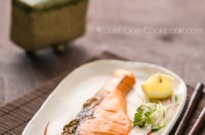Japanese Salted Salmon (Shiojake/Shiozake) • Just One Cookbook
In this easy Japanese Salted Salmon (Shiozake/Shiojake) recipe, I’ll teach you how to cut, salt, and broil your Japanese-style salmon fillets. Enjoy this flavorful salmon with crispy skin as a filling for rice balls, in a bento lunchbox, or as the wholesome centerpiece of a traditional Japanese breakfast.
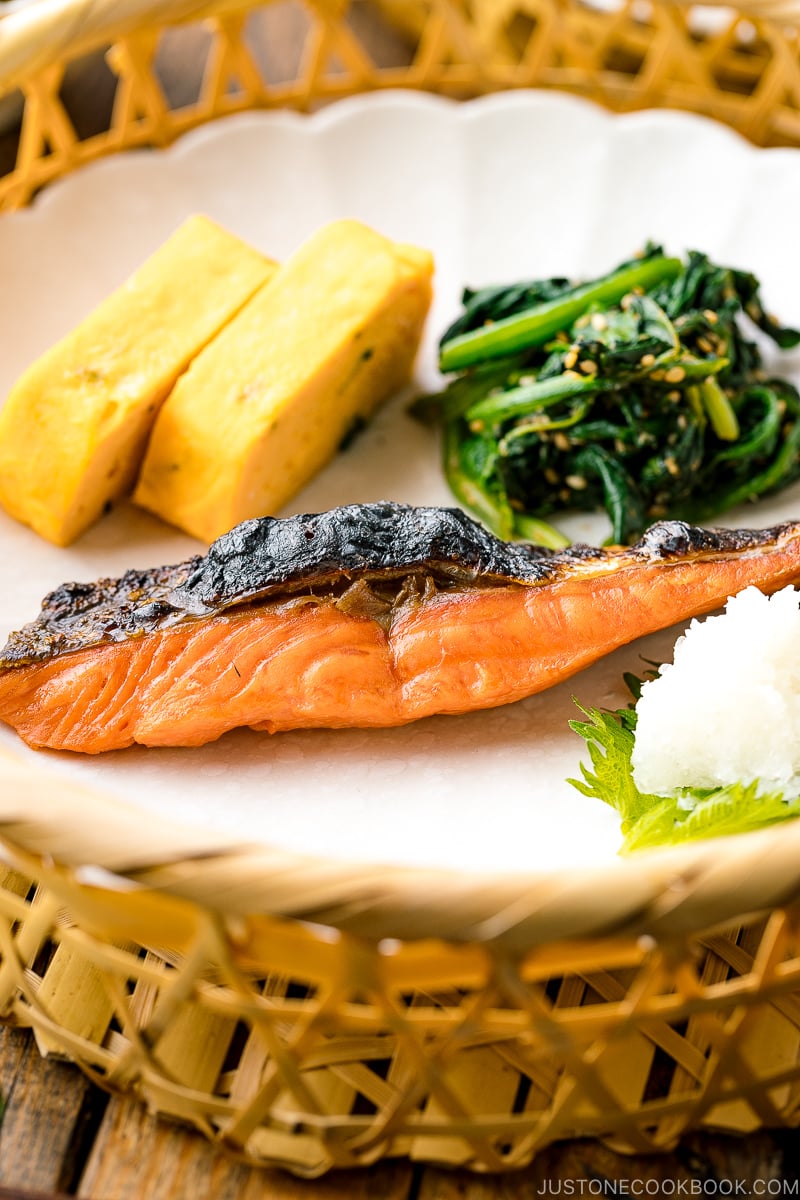
Surrounded by the ocean, fish and seafood has been a major source of protein for the Japanese people for centuries. I have many favorite fish and seafood dishes myself, but Japanese Salted Salmon (Shiozake or Shiojake) has to be one of the most classic grilled fish we enjoy of all time!
The natural richness and the charred flavor of the grilled salmon are simply wonderful to be eaten as a part of breakfast, lunch, or dinner. You’ll need only 3 simple ingredients to make this recipe at home!
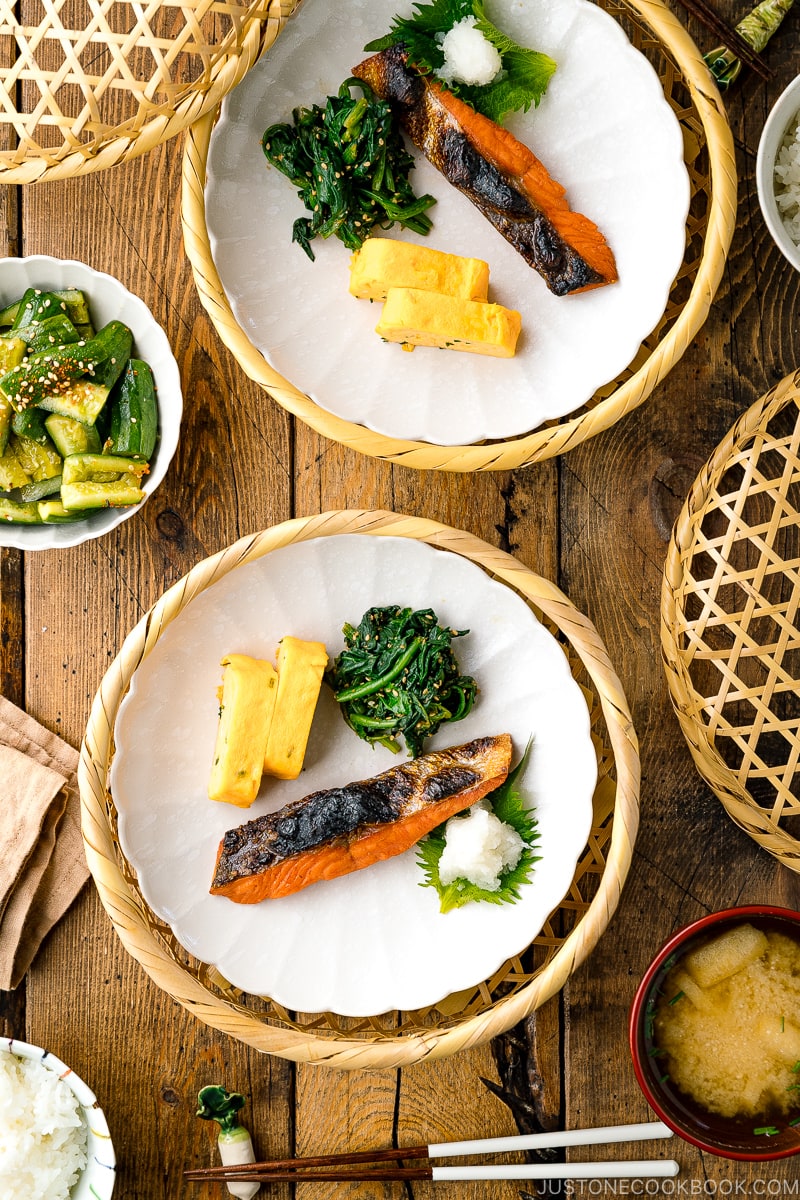
What is Japanese Salted Salmon?
Japanese Salted Salmon is called Shiozake or Shiojake (塩鮭) and it’s made of salmon and salt with the addition of sake to clean the fish.
If you have been to Japan, you probably have tried or seen traditional Japanese breakfast similar to the picture below.
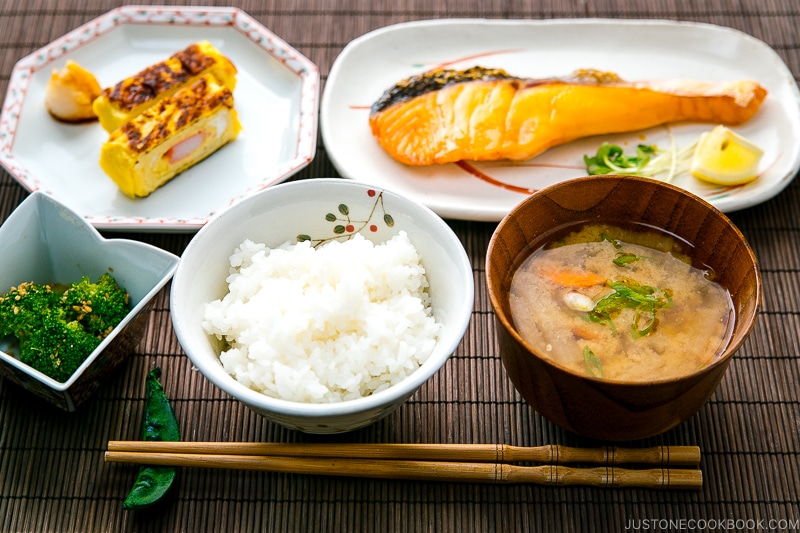
The breakfast set includes salted salmon (shiozake), steamed rice, miso soup (I made Tonjiru), a vegetable side (I made broccoli gomaae), and an egg dish (I made Tamagoyaki).
Aside from traditional Japanese breakfast, you may find salted salmon in a bento lunch box or as a filling for Japanese Rice Balls (Onigiri). Salted salmon is so versatile that I also use it in my Salmon Fried Rice, Ochazuke (a simple rice dish in green tea), and Okayu (Rice Porridge).
I used to buy prepared salted salmon from a Japanese supermarket for convenience. However, it can be a bit salty. Since my children love salted salmon and its crispy skin, I decided to slice the salmon fillets myself and started making my own salted salmon at home.
Turns out, it was ridiculously easy and economical that I didn’t need to buy the prepared salted salmon from Japanese grocery store anymore. I hope you are inspired to make your own, too!
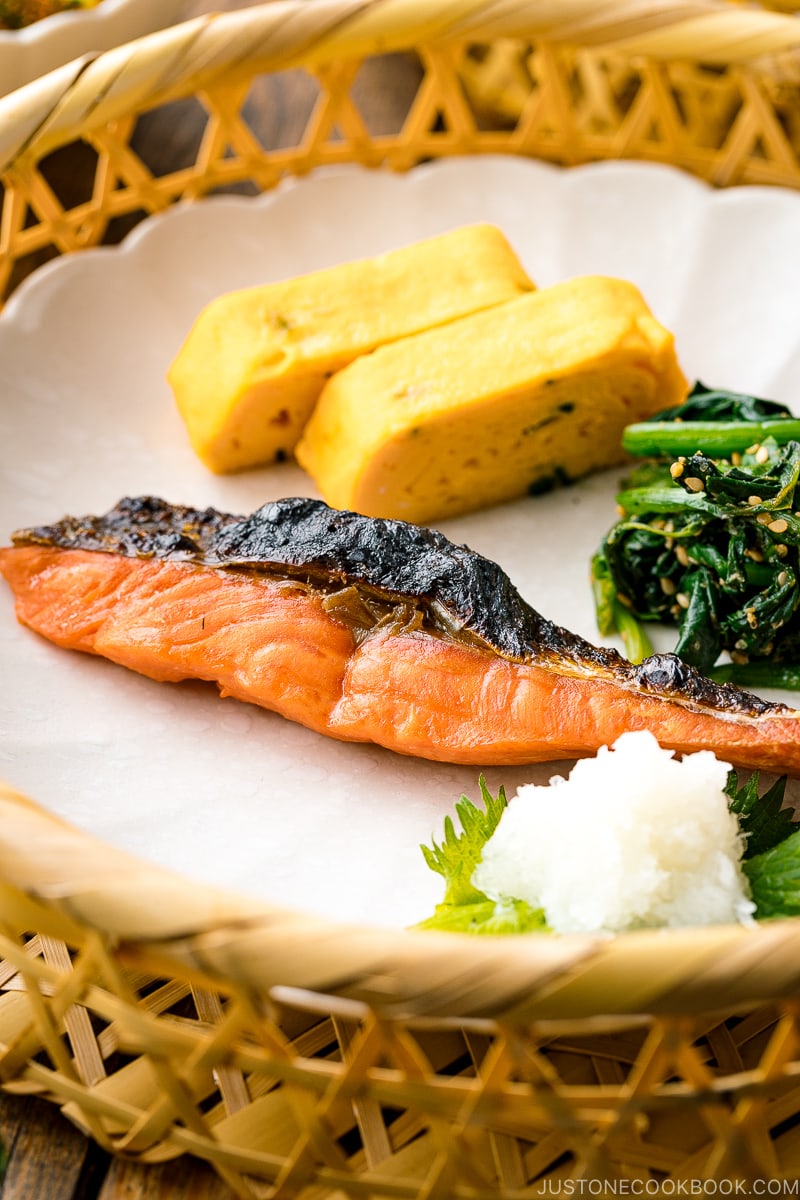
How to Make Japanese Salted Salmon
Ingredients You’ll Need
- Japanese-style salmon fillets (I recommend firmer and less-fatty Sockeye salmon; you can slice your own fillets)
- Salt (I use Diamond Crystal kosher salt)
- Sake to clean the fish
That’s it, just 3 simple ingredients!
Overview: Cooking Steps
Step 1: The salmon is marinated with sake and let rest for 10 minutes. Before salting, you want to make sure to pat the salmon surface dry with paper towels. Then sprinkle salt liberally on all sides, especially on the skin. The salting process not only helps to remove any fishy taste but also plays a role in enhancing umami and firming up the flesh of salmon. We will then wrap the fillets in a few layers in an air-tight container before keeping them chilled in the refrigerator for at least 2 days.
Step 2: After 2 days, wrap the fillet in plastic and store them in the freezer.
Step 3: Broil the salmon in the oven, or it can be grilled or pan-fried. The salmon will come out tender with a flavorful crispy skin.
You can make a larger batch of salted salmon at once and keep them frozen to enjoy at a later time.
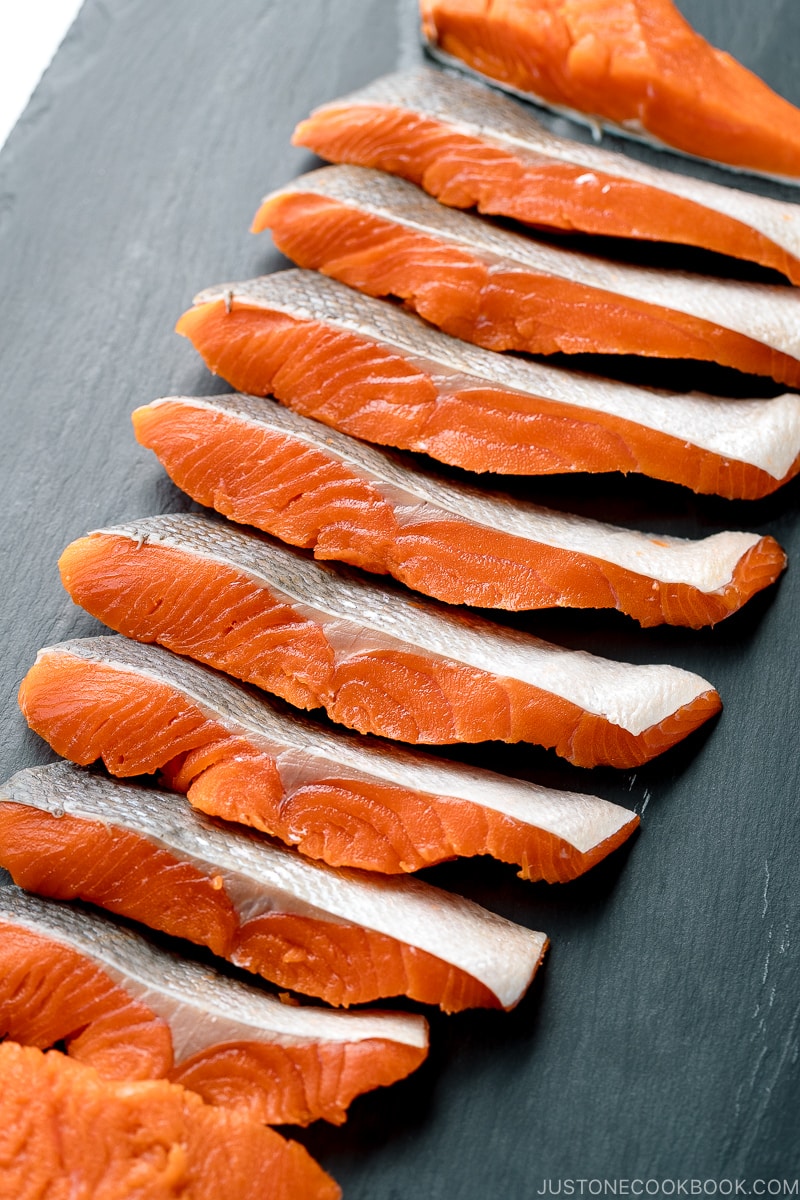
How to Cut Salmon into Japanese-Style Fillets
As I mentioned earlier, it’s very easy to cut a salmon fillet into Japanese-style thin fillets. Why do we have to cut it this way? The fillets are much thinner so it’s quicker to cook through. As it’s diagonally sliced, the salmon fillet has its skin on top of the fillet. It’s perfect for broiling the skin to achieve a crispy texture.
To cut the side of salmon, place the salmon skin side down with the narrow tail end to your left (the head end is wider). Next, cut off the tail’s narrowest part, which is too small for Japanese-style fillets. Tilt your knife back about 30 degrees and diagonally slice the salmon toward the tail end.
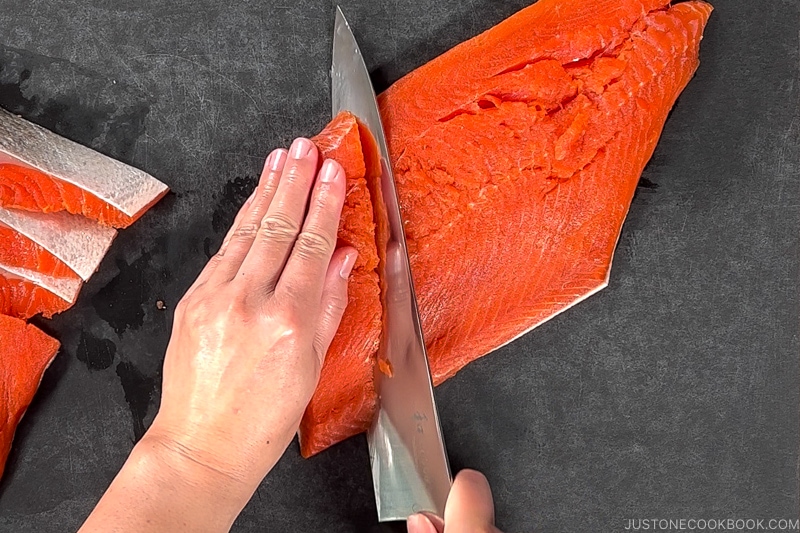
I decide the portion size based on the look of the salmon fillet and slice the fillet into 1 inch (2.5 cm) thickness. The typical Japanese-style fillets are 60-80 grams (2.1-2.8 ounces), which are much smaller fillets than Western-style fillets.
You can read the detailed tutorial on How to Cut Salmon into Japanese-Style Fillets.
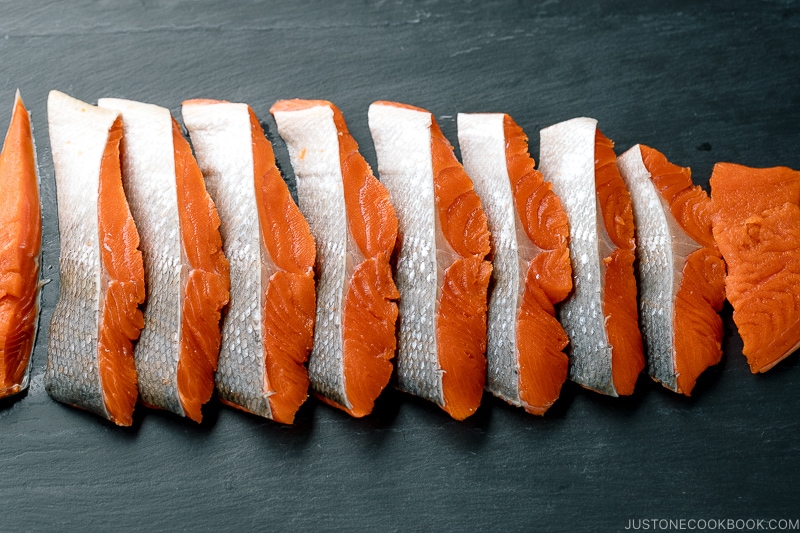
There you have it! You can use the same cutting technique to cut other kinds of salmon for Japanese-style fillets.
Salting Salmon with the Right Amount
Traditionally, when there was no refrigeration, salmon was salted to improve its shelf life and to keep up with the abundance of salmon catches. By salting, the water is removed and the fat is converted to amino acids, which results in improving the taste.
The higher the salt concentration is, the better the preservation is. Depending on the amount of salt, salted salmon is categorized into two types:
- ama-kuchi (甘口) (5-8% salt concentration)
- kara-kuchi (辛口) (8% or more)
However, people are more health-conscious these days, and the supermarkets sell their ama-kuchi salted salmon as 3%, chu-kara (中辛) as 5%, and kara-kuchi as 8% or more.
If you’re not familiar with Japanese fermented foods such as soy sauce, miso, umeboshi, and pickles, you may find the salted salmon a little strong on taste. Even for the Japanese, we do not eat salted salmon by itself, and we always eat a small portion of salted salmon (typically 3 oz or 80 g) with steamed rice.
Frequently Asked Questions
Do we need to use sake?
Sake (alcohol in general) has the effect of removing the odor of fish (and meat). You can prevent the odor by sprinkling sake directly on the ingredients and the odor will be also evaporated with the alcohol. If you don’t consume alcohol, you may skip sake.
It looks like a lot of salt. Can we reduce the amount?
5% of salt for shiozake (salted salmon) is standard in Japan. You can reduce the salt to 3-4%, but less ideal for longer preservation.
It’s too salty for me. How can I remove the saltiness?
The general method is to soak in dilute salt water or water to remove the salt, but the salt tends to be removed too much and become dry and watery.
The recommended method is to use sake and mirin to remove the salt. Put salted salmon in a mixture of 2 parts sake and 1 part mirin and keep in the refrigerator for 3 hours. Pat dry and ready to cook.

What to Serve with Shiozake
Japanese salted salmon is such a delightful dish to enjoy, especially for traditional Japanese breakfast. Make sure you have good-quality Japanese short-grain rice and miso soup to go with this dish. I’ve also served:
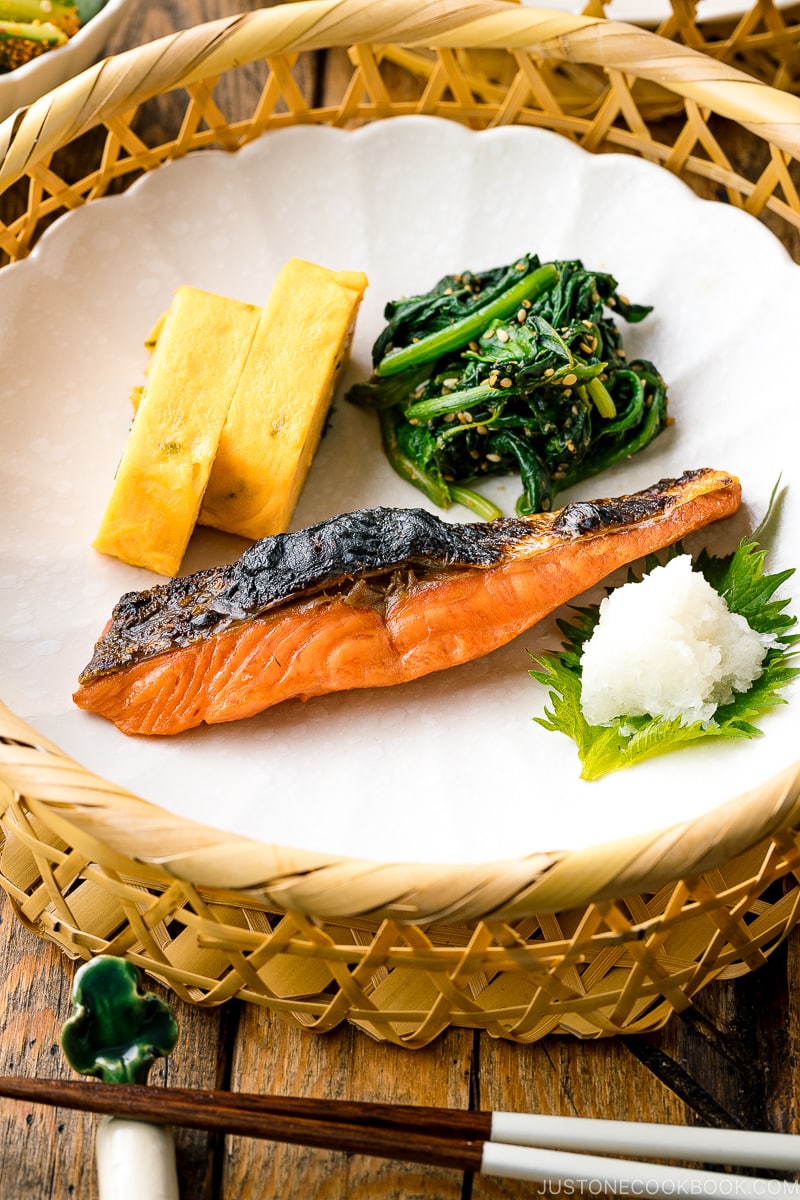
Other Delicious Japanese Salmon Recipes
Tableware from Musubi Kiln
I’ve partnered with a great ceramic online shop from Japan called Musubi Kiln. You will get 10% off with a coupon code JUSTONECOOKBOOK for your purchase. In this post, I’ve used:
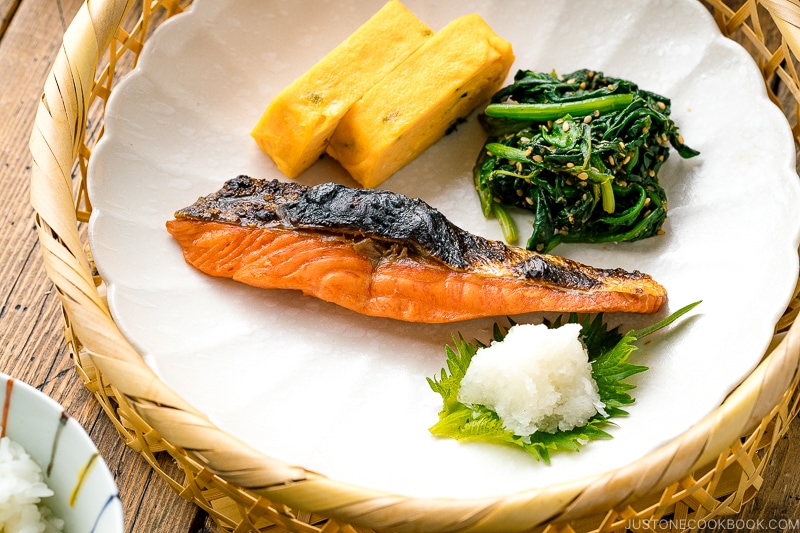
Wish to learn more about Japanese cooking? Sign up for our free newsletter to receive cooking tips & recipe updates! And stay in touch with me on Facebook, Pinterest, YouTube, and Instagram.
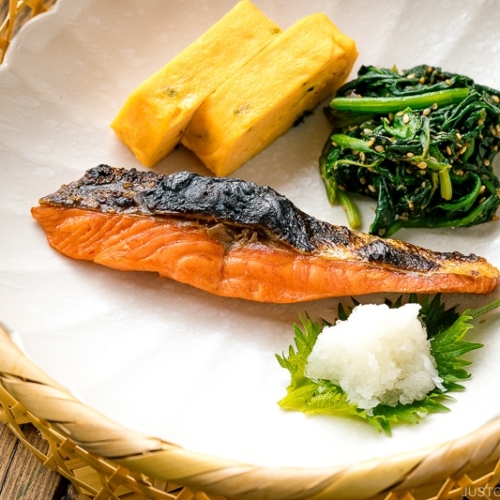
Japanese Salted Salmon (Shiojake/Shiozake)
In this straightforward recipe for Japanese Salted Salmon (Shiozake/Shiojake), I’ll teach you how to cut, salt, and broil your Japanese-style salmon fillets. Enjoy this flavorful salmon with crispy skin as a filling for rice balls, in a bento lunchbox, or as the wholesome centerpiece of a traditional Japanese breakfast.
Ingredients
Instructions
To Cut the Side of Salmon into Japanese-Style Fillets
After 2 Days
-
Open the container after 2 days and you’ll see that the salt has drawn out the moisture from the salmon. The fillets are darker in color and firmer in texture. Discard the wet paper towels.
-
Gently pat dry the fillets with a paper towel to get rid of any excess moisture. The salted salmon fillets are now ready to use.
Before You Cook…
-
Defrost the fillets completely in the refrigerator overnight. It is a good idea to let the salmon sit out for 15 to 20 minutes before cooking so that it can warm to room temperature. Do not let it sit out for too long. Here, I will cook two fillets.
To Broil (Recommended)
-
Preheat the oven setting to Broil High* (550ºF/288ºC) for 5 minutes and keep the oven rack placed in the center position or 9 inches* (23 cm) away from the top heating element. Line a baking sheet with foil for easy clean up and grease it with (spray) cooking oil. Place the salmon on the foil, skin side up (for crispy skin). Tip: When broiling, you don’t control the temperature in the oven; instead, you control the distance between the broiler and the surface of the food. It’s similar to using hotter and cooler zones on your grill.
-
Broil the salmon for 8-10 minutes. Please remember that the cooking time varies depending on the thickness of the fish and the distance between the broiler and the food. Japanese salted salmon is cooked until well done (more dry and flaky). You do not need to flip it.
Nutrition
Calories: 182 kcal · Carbohydrates: 1 g · Protein: 25 g · Fat: 8 g · Saturated Fat: 1 g · Polyunsaturated Fat: 3 g · Monounsaturated Fat: 3 g · Cholesterol: 69 mg · Sodium: 755 mg · Potassium: 612 mg · Vitamin A: 50 IU · Calcium: 15 mg · Iron: 1 mg
Editor’s Note: This post was originally published on December 2, 2012. The post has been updated with new images and more helpful content in March 2022.

